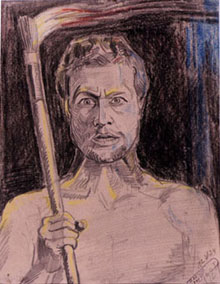Aleksanteri Ahola-Valo
show This article may be expanded with text translated from the corresponding article in Finnish. (March 2009) Click [show] for important translation instructions. |

Aleksanteri Ahola-Valo (27 January 1900, in Impilahti – 15 September 1997) was a Finnish artist, architect and thinker. Inventor of "AE-evohomology" life philosophy.[1] He was a witness to the Russian Revolution.
At the age of 14 he wrote a play, Aikuiset ja lapset kasvatuksen pyörteissä.
Ahola-Valo studied at the Vitebsk Art and Graphic Studios in Belarus (1921–1922), and at the Odessa Art Institute in Ukraine (1923–1925).[2]
In 1925 he took part in the Battleship Potemkin silent film. In 1930 he designed "The temple of violence of mankind" in Minsk, Belarus. In 1939–1940 Ahola-Valo was imprisoned for political reasons in the Tammisaari prison camp in Finland. He was one of the last surviving cast members of Battleship Potemkin, if not the last.
References[]
- ^ Karjalainen, Tuulia (2003). "Ahola-Valo, Aleksanteri (1900 - 1997)". National Biography of Finland (in Finnish). Retrieved 28 December 2016.
- ^ "Ray of Light". Art Museum. Archived from the original on 5 March 2016. Retrieved 28 December 2016.
External links[]
 Media related to Aleksanteri Ahola-Valo at Wikimedia Commons
Media related to Aleksanteri Ahola-Valo at Wikimedia Commons
- 1900 births
- 1997 deaths
- People from Pitkyarantsky District
- People from Viipuri Province (Grand Duchy of Finland)
- Finnish writers
- 20th-century Finnish painters
- 20th-century male artists
- Finnish male painters
- Finnish people stubs